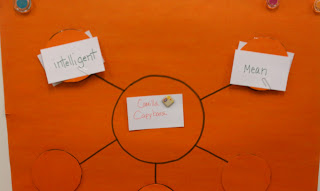1
|
2
|
3
|
4
|
5
|
6
|
7
|
8
|
9
| |
8(A) seq & summ
main events in fiction
|
x
|
x
| |||||||
13 (C) cause & effect
in exposotory
|
x
|
x
| |||||||
19(E) summarize
|
x
|
x
| |||||||
8(B) characters in fiction
|
x
|
x
|
x
| ||||||
19(D) inference
|
x
|
x
|
x
|
x
|
x
| ||||
4(A) affixes
|
x
|
x
| |||||||
4(B) context clues
|
x
|
x
|
Wednesday, August 31, 2011
9 week @ a Glance
Figure 19 (D) - Inferencing
19(D) | |||||
K | 1 | 2 | 3 | 4 | 5 |
Make inferences based on the cover, title, illustrations, and the plot | Make inferences using about text and use textual evidence to support understanding | ||||
Make inferences about the text Use textual evidence to support understanding | |||||
Activities:
- Interactive Read Aloud by Linda Hoyt page 29 using Where the Wild Things Are and the extentions
- CTK: make reference to the formula from the primary inferencing book
- Reader's make inferences about characters while they read....see character development TEK 8(B)
- Visual Inferencing - the team will search for images that allow the kids to draw conclusions from, then the kids will use the template below to note the visual clues as well as their background knowledge
- Clues to Comprehesion book (Carson)
- Blue Skill Bags - making inferences
- visual inferencing activity from above can be taken to a center
8(B) - Character Interaction
Students understand, make inferences and draw conclusions about the structure and elements of fiction and provide evidence from the text to support their understanding | |||||
K | 1 | 2 | 3 | 4 | 5 |
8(B) describe characters in a story and the reason for their actions | 9(B) describe characters in a story and the reasons for their actions and feelings | 9(B) describe main characters in works of fiction, including their traits and motivations, and feelings | describe the interaction of characters including their relationships and the changes they undergo third grade 8(B) fourth grade 6(B) | 6(B) explain the roles and functions of characters in various plots, including their relationships and conflicts | |
Describe the interaction of characters Describe the interaction of characters including their relationships Describe the interaction of characters including the changes they undergo | |||||
Activities:
- Linda Hoyt -Read Aloud Think Together - Character Development page 117
- Feeling & Emotion Chart - create the chart that helps students catagorize feelings , as the class or individuals come across feeling words they can add them to the chart
- Create a Bubble Map showing character traits and the textual evidence..see below
After reading a text, determine a character's traits |
 |
| Beneath the trait, provide textual evidence |
- character trait cards (english & spanish) - first class, elementary lang arts, curriculum, fluency,character traits
- these cards can also be used in a fluency anchor station (seee below)
- Making inferences about characters
- As we read a text, take note of character feelings/emotions and how they change within the text. We discussed several graphic options to illustrate those changes...see images below
- Fairy Tales were suggested as a resource for character development to reinforce week 2 supporting standard - 5(A) paraphrase the themes and supporting details of fables, legends, mythsor stories
Anchor Activities:
- character trait cards with fry phrases
Possible Test Questions:
Tuesday, August 30, 2011
Figure 19 (E) - week 3 & 4
Figure 19 (E) | |||||
K | 1 | 2 | 3 | 4 | 5 |
Retell or act out important events in stories | Retell or act out important events in stories in logical order | Retell important events in stories in logical order | Summarize information in text, maintaining meaning and logical order | Summarize and paraphrase text in ways that maintain meaning and logical order within a text and across text | |
Summarize information in text maintaining meaning Summarize information in text maintaining logical order | |||||
Activities:
Marzano's Summarizing & Note-Taking Activities
(shared by Science coaches September 15th)
- Sketch -It
- Don't Break the Bank
- Magnet Summary
- 3-2-1
- Concept Definition Map
- Picture Notes
- Incredible Shrinking Notes
- Mind Mapping
Anchor Activities:
Possible Test Questions:
13(C) - Identify details to support the main idea - week 3 & 4
Reading/ Comprehension of Informational Text/ Expository Text Students analyze, make inferences, draw conclusions about expository text and provide evidence from text to support their understanding | |||||
K | 1 | 2 | 3 | 4 | 5 |
10(A) identify the topic and details in expository text heard or read, referring to the words and/or illustrations | 14(A) restate the main idea, heard or read | 14(A) identify the main idea in a text and distinguish it from the topic | 13(A) identify the details or facts supporting the main idea | 11(A) summarize the main idea and supporting details in text in ways that maintain meaning | 11(A) summarize the main ideas and supporting details in a text in ways that maintain meaning and logical order |
Identify the details or facts that support the main idea | |||||
Activities:
- Linda Hoyt - Read Aloud Think Together - Identify Main Ideas and Supporting Details with The Art Lesson by Tomie de Paola

- Comprehension Toolkit - Book 5 Determining Importance
- Lesson 16 - Figure out what's important
- Lesson 17 - Paraphrase Information
- Marzano's Summarizing & Note-Taking Activities
- Sketch -It
- Don't Break the Bank
- Magnet Summary
- Incredible Shrinking Notes
- Mind Mapping
- Get The Gist
Anchor Activities:
Possible Test Question:
Subscribe to:
Posts (Atom)










